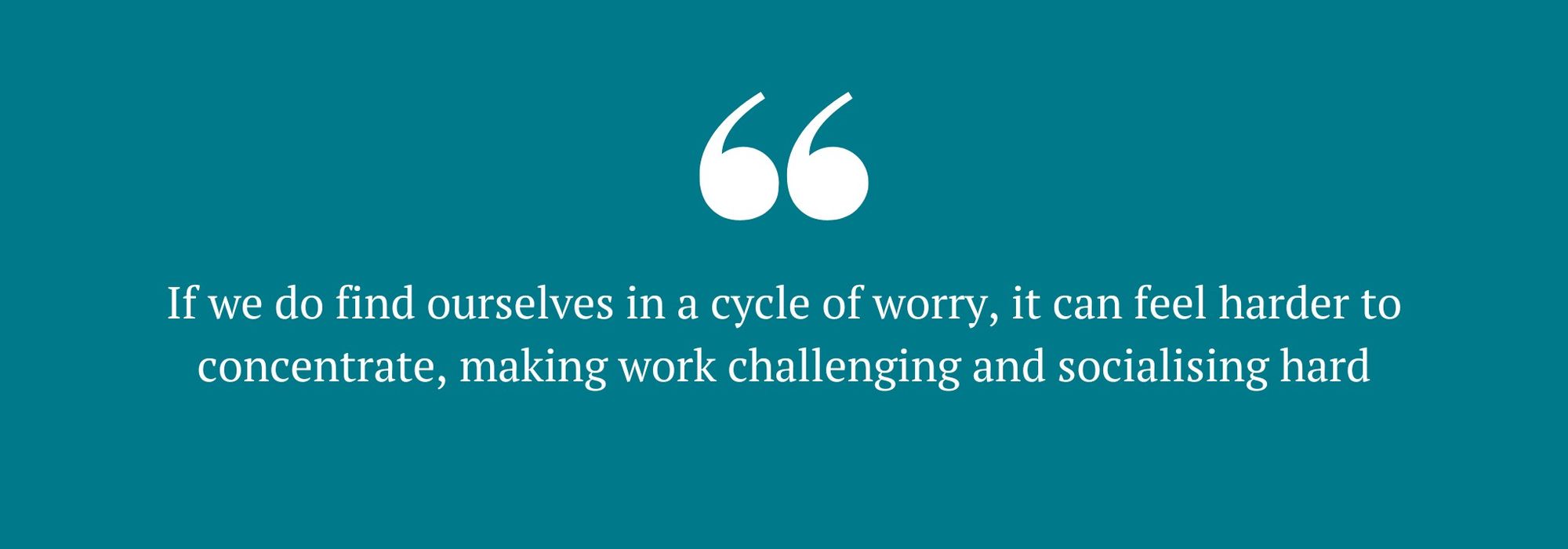Scheduling a set period every day to confront your anxious thoughts could help you to manage them. Ready to give it a go?
Like many, I struggle with anxious thoughts throughout the day, leaving me exhausted and stressed. But could scheduling some daily time to worry help?
It might sound counter-intuitive to dedicate time to worries, but scheduling a set period for worrying can help stop your anxieties from seeping into the rest of your day, making them more manageable.
The impact of worrying
Worrying throughout the day can have a negative impact. Counsellor Amy Drake explains: “Depending on the severity of the anxiety, it can be present as soon as we wake, which makes it harder to do everyday tasks such as getting up and dressed. If we do find ourselves in a cycle of worry, it can feel harder to concentrate, making work challenging, and socialising hard.” Everything from our diet to our sleep can be affected.
What exactly is a ‘worry time’?
Scheduling a worry time is a technique sometimes taught in cognitive behavioural therapy (CBT). “The aim is to help individuals stop the cycle of worry from perpetuating by allowing one specific time to focus on challenging thoughts,” Amy says.
“The idea is that you note a designated time during the day that you will allow yourself to worry. You can then choose to use the time to manage worries rather than dwell on them. The space is for identifying if there’s anything you can do to practically solve the worry, such as an issue with work, and then finding steps to implement.
“If it’s out of your control, the time is used to practise accepting that you can’t control the outcome, and letting go of the thought,” says Amy. “It can be useful in helping to limit the thought cycle during the day, and help us to feel more equipped at managing future worries.”
Setting a worry time
It’s a technique I’ve been aware of for a while, and as a chronic worrier, I’m interested to give it a try.
Amy advises a daily worry time is tailored to your personal schedule. To start out, she recommends reserving more time, such as an hour, and then decreasing this down as you get more practised at the skill.
An environment where you feel safe is important, where it’s quiet and uninterrupted. Try not to use your bed, as this can mean it becomes associated with stress, which can affect your sleep.
Amy adds that it takes practice, so I’m not expecting it to be a quick fix.

Giving it a go
I think about my standard day, and how I could fit in a worry time. I decide on a half hour at around 4.30pm, when I’m usually starting to wind down from work, but am not in my evening relaxation mode yet.
I sit at the dining table with a notebook and pen, and jot down a few things that have been bothering me. I then do as Amy suggests, and try to think of solutions for these. Some of them, I realise, do have answers. The messy kitchen counter I was fretting about? I can plan to tidy it this weekend. That piece of work I’m struggling with? There is someone I can ask for advice. By the end of the half-hour, I have a plan for the worries I have some control over.
And now for the tricky bit: ending the worry time.
“This can be a challenging part of worry time – stopping!” Amy reassures me. “Firstly, it’s useful to create an actionable plan on how worry time will work for you, and this includes a plan for what to do when worry time has ended. Calling or meeting a friend afterwards, going to cook a new recipe, or watching a TV show that you know takes your attention, are all useful when stopping worry time.”
I decide that after worry time, I will chat to my husband, who has just finished work. This is usually how I spend this part of the day, so it feels like a natural way to transition out of worry time and into the evening. It helps me stop fixating on the worries I haven’t been able to solve, and remember that I have time tomorrow to deal with the ones I can.
Creating a habit
Over the next week, I schedule worry time each day.
Of course, I still worry outside of this. “It can be useful to write worries down when they come, and put them all in the same place, so that you know you will remember to tackle them,” advises Amy.
“In the moments your thoughts start to wander, try some simple mindfulness tools to bring you back to the present moment – focus on all the blue things in the room for example, call an uplifting friend, or if you are working, set yourself a deadline to focus on and complete a task. Find something that you know can take your focus back to the here and now.”
If I notice a worry keeps cropping up, I note it down ready to revisit later. I tell myself: “You don’t need to think about this now.” As I do this, I realise that it becomes easier to park that worry. I’ve not dismissed it, or tried to bury it, but I’ve simply said I’ll come back to it when I’m ready.
It takes time to get used to this technique – I’m still getting the hang of it. But so far, I’ve noticed I dwell on things less in the day, and feel better able to deal with them. So, I guess, that’s one less thing to worry about.


Comments